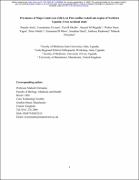| dc.contributor.author | Atim, Pamela | |
| dc.contributor.author | Loum, Constantine S | |
| dc.contributor.author | Okello, Tom Richard | |
| dc.contributor.author | Magada, Samuel M | |
| dc.contributor.author | Yagos, Walter Onen | |
| dc.contributor.author | Abelle, Peter | |
| dc.contributor.author | Moro, Emmanuel B | |
| dc.contributor.author | Huck, Jonathan | |
| dc.contributor.author | Redmond, Anthony | |
| dc.contributor.author | Nirmalan, Mahesh | |
| dc.date.accessioned | 2021-05-12T10:15:37Z | |
| dc.date.available | 2021-05-12T10:15:37Z | |
| dc.date.issued | 2020 | |
| dc.identifier.citation | Atim, P., Loum, C. S., Okello, T. R., Magada, S. M., Yagos, W. O., Abelle, P., Moro, E. B., Huck, J., Redmond, A., & Nirmalan, M. (2020). Prevalence of Major Limb Loss (MLL) in Post conflict Acholi sub-region of Northern Uganda: Cross sectional study [Preprint]. Pathology. https://doi.org/10.1101/2020.05.14.095836 | en_US |
| dc.identifier.uri | https://doi.org/10.1101/2020.05.14.095836 | |
| dc.identifier.uri | https://hdl.handle.net/123456789/249 | |
| dc.description.abstract | Background: Awareness of residual disabilities amongst people living in countries recovering
from prolonged armed conflicts and their socio-economic consequences is increasing. Robust data
on the prevalence of such disabilities are important for planning cost effective health services. This
study outlines the first community-based prevalence study of Major Limb Loss (MLL) in the
Acholi sub region of Northern Uganda. The generic lessons learnt are relevant to many other postconflict
societies in Asia and Africa.
Methods: A cross sectional survey using random cluster sampling was conducted across 8,000
households in eight districts, of which 7,864 were suitable for analysis. The households were
sampled randomly using a high-resolution population model generated using a combination of
census data and artificial intelligence. Data were collected using semi-structured questionnaires
administered by trained staff, and results were statistically analysed to identify patterns.
Results: Data obtained from 7,864 households demonstrated that 47.9% (3,763) of households
contained people with disabilities, and 3.0%, (237) of households contained people living with
MLL. Of those exhibiting disabilities, the most common types were physical disabilities affecting
mobility and other conditions limiting vision or hearing. Our analysis suggests that MLL sufferers
are disproportionately male, older and less well educated than the general population. Using the
identified prevalence rate of MLL (0.6%) and an estimated population value for the Acholi Sub-
Region of 1.9 million, we estimate that there are approximately 11,400 MLL sufferers in the region
who require long-term rehabilitation services.
Conclusions: This is the first large scale study on the prevalence of MLL following the Ugandan
civil war - known for extreme forms of violence, cruelty and mutilation. Our study demonstrates
the magnitude of the problem still faced by the affected people, almost 15 years after the end of
large scale combat, and the relative paucity of rehabilitation services to meet their needs. Suitable
alternative health policy frameworks are required to address these relatively invisible needs. | en_US |
| dc.language.iso | en | en_US |
| dc.publisher | BioRxiv | en_US |
| dc.subject | Northern Uganda | en_US |
| dc.subject | Acholi sub-region | en_US |
| dc.subject | Prevalence of Major Limb | en_US |
| dc.title | Prevalence of Major Limb Loss (MLL) in Post conflict Acholi sub-region of Northern Uganda: Cross sectional study | en_US |
| dc.type | Article | en_US |

